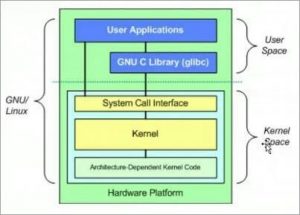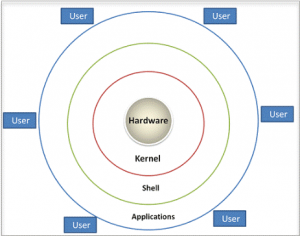What is Linux?
Linux is an operating system. It has Graphical User Interface. It is Unix-like, open source and community-developed operating system (OS) for computers, servers, mainframes, mobile devices and embedded devices.
How is the Linux operating system used?
Every version of the Linux OS manages hardware resources, launches and handles applications, and provides some form of user interface.
For example, Linux has emerged as a popular OS for web servers such as Apache, as well as for network operations, scientific computing tasks that require huge compute clusters, running databases, desktop and endpoint computing, and running mobile devices with OS versions like Android.
Linux is highly configurable and depends on a modular design that enables users to customize their own versions of Linux.
The pros and cons of using Linux
Some advantages of using Linux include:
- Open source software. The Linux kernel is released under the GNU GPL open source software license. Most distros include hundreds of applications, with many options in almost every category.
- Licensing costs. Unlike Microsoft Windows or Apple macOS, Linux has no explicit licensing fees. While system support is available for a fee from many Linux vendors, the OS itself is free to copy and use.
- Linux is considered a reliable OS and is well-supported with security patches. Linux is also considered to be stable, meaning it can run in most circumstances. Linux also copes with errors when running software and unexpected input.
- Backward compatibility. Linux and other open source software tend to be updated frequently for security and functional patches, while retaining core functionality. Configurations and shell scripts are likely to work unchanged even when software updates are applied.
- Many choices. Between the hundreds of available distributions, thousands of applications and almost infinite options for configuring, compiling and running Linux on almost any hardware platform, it is possible to optimize Linux for almost any application.
Difference Between Linux and Windows Operating Systems In Terms of Architecture, Performance, And Security:
- Both Linux and Windows are the well known operating systems.
- When we talk about comparing these two, we should first understand what an operating system is and then get to know the basics of Linux and Windows before starting with the comparison between them.
- An operating system is low-level system software that handles the computer’s hardware and software resources and facilitates the computer’s basic functions like task scheduling, resource management, memory management, controlling peripherals, networking, etc.
Linux Architecture
As we can see in the above figure, Linux Architecture also has two layers i.e. user space and kernel space. Within these layers, there are four main components i.e. Hardware, kernel, System call interface (aka Shell) and User applications or utilities.

The hardware is comprised of all the peripheral devices which are attached to the computer such as terminals, printer, CPU, RAM. Now comes the monolithic Kernel which is the core of the OS.
The Linux kernel has many subsystems and other components too. It is responsible for a lot of critical tasks like process control, networking, accessing peripherals and file system, security management and memory management.
Simplified Architecture of Linux

The shell acts as an interface between the user and kernel and presents the services of the kernel. There are around 380 system calls. For Example, start, read, open, close, exit, etc. Shell receives commands from the user and executes the kernel’s functions.
Shell is classified into two categories i.e. command line shells and graphical shells. In the outermost layer of the architecture, and we have applications which execute on the shell. It can be any utility program like a web browser, video player, etc.
Linux And Windows Security Comparison
While talking about security, though Linux is open source, however, it is very difficult to break through and hence it is a highly secure OS when compared to the other operating systems. Its high-tech security is one of the main reasons for Linux popularity and enormous use.
Meanwhile, Linux is open source and has a strong user community. As the entire user base has access to the source code, they can monitor for issues and there are high chances for any vulnerability to be caught earlier than the hackers target it.
Moreover, Linux users will investigate and fix the issue then and there as it is open source. This way, Linux receives a great level of maintenance from its community of developers.
On contrary to this, Windows users can’t fix the issue by themselves as they don’t have the permission to modify the source code. If they catch any vulnerability in the system, then they will need to report it to Microsoft and then wait for it to get fixed.
In Windows, the users have full admin access over the accounts. Thus, when a virus attacks the system, it quickly corrupts the whole system. So, everything is at risk in case of Windows.
On the other hand, Linux enjoys the perk of accounts where limited access is given to the users and hence in case of any virus attacks, only a part of the system will be damaged. The virus won’t be able to affect the whole system as Linux does not run as root by default.
In Windows, we do have a UAC (user account control) mechanism to control the access privileges, though it is not as robust as Linux.
Linux uses IP tables to boost up the security of the system. Iptables help in controlling the network traffic by configuring certain rules enforced through the Linux kernel firewall. This aids in creating a more secure environment for running any command or access to the network.
Linux has segmented working environments which secure it from the attack of virus. However, Windows OS is not much segmented and thus it is more vulnerable to threats.
Another significant reason for Linux being more secure is that Linux has very few users when compared to Windows. Linux has nearly 3% of the market whereas Windows captures more than 80% of the market.
Thus, hackers are always more interested in targeting Windows as the virus or malicious software they create will affect a large segment of users. This, in turn, keeps Linux users safer.
In a nutshell, we can say that Linux has some features which make it more secure than Windows and the other operating systems.
Differences Between Linux Security and Windows Security
The security differences between the two operating systems can be broken down into simpler concepts by taking out of account the elements that do not affect most casual computer and Internet users.
Modularity and User Privileges
Windows is not modular; you may have noticed that when one part of your computer goes bad, the whole thing goes down like a house of cards. When all of an operating system’s components wind together, it becomes easier from malware to get from your mail client to your system files. Unlike Windows accounts, Linux user accounts typically do not have root access, which is required to make major changes to the system. If malware gets into the system, it has no way to spread without that access.
Automated Functions
Most users just want their computer to work, without having to spend too much time configuring files and solving technical problems. Windows accommodates this; it automates as many functions as possible for the user, which gives malware a chance to sneak in. Chad Perrin of TechRepublic uses the example of executable malware disguised as a Word document. When the user opens this file, instead of running Word, Windows follows the execution cues in the file. Another example he provides is of malware that runs when a user inserts removable media; such malware takes advantage of Windows’ autorun feature.
Open-Source and Transparency
Linux is open-source, which means that anyone can view and modify the source code that runs the operating system; it is part of the reason why there are so many different versions (called distributions) of the Linux operating system. If a vulnerability is present in a program or distribution, developers tend to find it faster and find solutions to close that vulnerability. While open-source programs exist for Windows, the operating system as a whole is closed.
Security Through Variety
While it is not exactly a security feature, the variety available to Linux users in both operating system and applications makes it much harder for malware to target a majority of users. Windows users make up about 90 percent of computer users and only vary by five versions, with more than 47 percent of users on Windows 7 in January 2014. Linux only has about 1.5 percent of Internet users overall, and these users vary between several different distributions. While Ubuntu is by far the most popular version of Linux, versions like Fedora and openSUSE use a different set of tools and applications.